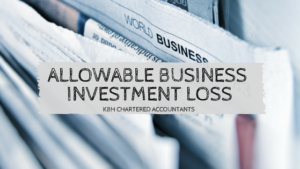Lets make it easy and start off with a definition: an allowable business investment loss is a specific type off loss that can occur when you sell or get rid of shares in a small business corporation, or when a debt is owed to you by a small business corporation. This can arise in a few ways:
1) Through a disposition of shares in a small business corporation,
2) Through a disposition of debt owed to you by a small business corporation,
3) When amounts that you have loaned to a small business corporation become un-collectible, or the corporation has gone bankrupt, insolvent or was wound up during the year.
Note:
- All transactions must be with corporations that are of no relation to one another.
- The corporation must use 90% or more of their assets in a business carried on in Canada.
- A business investment loss cannot be claimed on shares in public companies, or companies controlled by non-residents.
- The loss refers to the 50% portion deductible for tax purposes.
Advantage:
Claiming an allowable business investment loss is deductible against all types of income, not just capital gains. This can be any income whether it’s employment, rental, or investment — your overall tax bill will be reduced in the year that the allowable business investment loss is claimed. This may be planned out to ensure your allowable business investment loss occurs in the best year possible.
The CRA regularly audits allowable business investment loss claims, so meet with your accountant (us) to be sure that you meet the requirements before claiming.
The allowable business investment loss is claimed on line 217 of your T1 Personal Income Tax Return.
How to best utilize the allowable business investment loss:
For starters, you could deduct half of the investment business loss from your income. The actual amount of loss you deduct is considered your allowable business investment loss.
If your investment loss is more than your annual income, you can include the additional amounts as part of your non-capital losses for the year. These can be carried forward up to 10 years, and back up to 3 years.
Your claims must include a thorough note to the CRA and can be sent along with your income tax return. This note should contain the name of the business corporation, the number and class of shares or type of debt disposed of, the date of either insolvency, bankruptcy, or wind-up, the date when you purchased shares or debt, the proceeds on disposition, the cost base, any expenses incurred on the disposition, and the actual amount of the loss.
As always, it’s best to contact your accountant or business advisor before making any claims that could be audited by the CRA in the future. Contact us for more information!
info@kbh.ca
